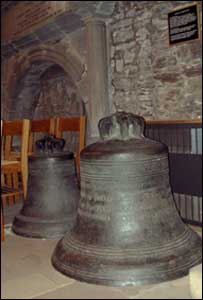History of the Bells
There are two old bells which are now located in the north aisle of the Cathedral called the Great and Lesser Bells (see photograph).

The inscription on the Great Bell reads “I was founded in Edinburgh, 1612, by the care of William Blaikwood, Bailie of Dunblane, and stayed still so in my exercise till 1657 when I was broken by the unskilful direction and handling of some men and by the care and expense of Harie Blaikwood, Bailie of Dunblane, the son of William, I am founded again at Brimin by M. Clavdigage, Anno 1660. Recast 1809 by T. Mears & Son of London out of funds of the Kirk Session of Dunblane.”
The inscription on the Lesser Bell reads “Founded by Lieutenant General Drummond in the year 1687 and refounded by the Kirk Session in the year 1723. Robertus Maxwell Fecit, Edinburgh.”
The bells were rung regularly both on a daily basis and for special occasions such as victories at Trafalgar, Waterloo and a Royal visit by Queen Victoria in 1842.
In 1907 Robert Younger, Esq. offered to provide an adequate chime for the tower along with a clock capable of striking the quarters and the hours. It was thought that the tower would not be strong enough to support bells that ring full circle due to the age of the tower. In 1908 nine bells were installed that could be chimed by clavier (keyboard) connected by wires to the clappers hanging inside the bells or by Ellacombe connected by ropes to hammers which strike on the bells. When the bells were originally installed eight of them were fixed and one bell (the A natural) was hung for ringing full circle.
All the bells were made by the founder Messrs Taylor & Co. Bellfounders of Loughborough in 1908.
The bells were first chimed for the visit of King Edward VII to Dunblane on 28th September 1908.
When Robert Younger died in 1948 he bequeathed money to the Cathedral to rehang the chime of bells so they could be rung full circle for change ringing. This work was done in 1951 when the tower was reinforced and the Treble and 2nd bell were recast.
The weight, note and inscriptions on the bells are detailed below.
Bell
Treble
2
3
4
5#
5
6
7
Tenor
Weight (Cwt-qt-lbs)
5-0-20
5-3-16
6-0-2
7-3-11
9-0-16
10-1-14
12-3-19
16-3-26
24-2-24
Width
2ft 4.43 ins
2ft 5.93ins
2ft 7.63ins
2ft 11ins
3ft 0.5ins
3ft 2.5ins
3ft 5ins
3ft 9.5ins
4ft 3.5 ins
Note
E flat
D
C
B flat
A
A flat
G
F
E flat
Inscription (Translation)
Ora et Vigila (Pray and Watch)
Ora Labora (Pray Work)
Fugit Hora (Time Flies)
Unquam Nunquam (Ever Never)
Sursum Corda (Lift up your Hearts)
Hodie Cras (Today Tomorrow)
Absit Hora (Let there be no Delay)
Adest Hora (The hour is at Hand)
This chime of eight bells with turret clock and with one ringing bell was gifted by Robert Younger, a Scotsman by birth, King's Counsel, London 1908. Servite Domino in Laetitia (Serve the Lord in Gladness)
* Bell weights are usually given in hundredweights (cwt), quarters and pounds. 1 hundredweight = approximately 50kg.
For many years there was no local band of ringers. The first peal was rung on the bells on 10th August 1962 when a group of visiting ringers rang a peal of Belgrave Surprise Major.
A group of local ringers started to learn how to ring in August 1974 and there has been a band of regular ringers ever since.

